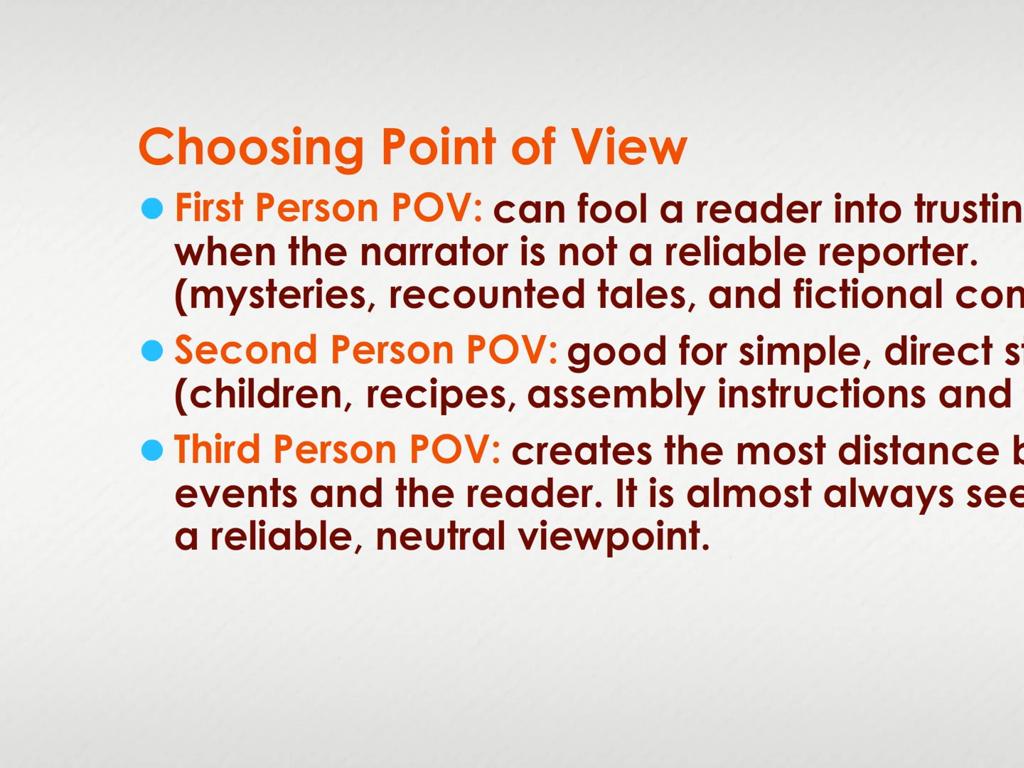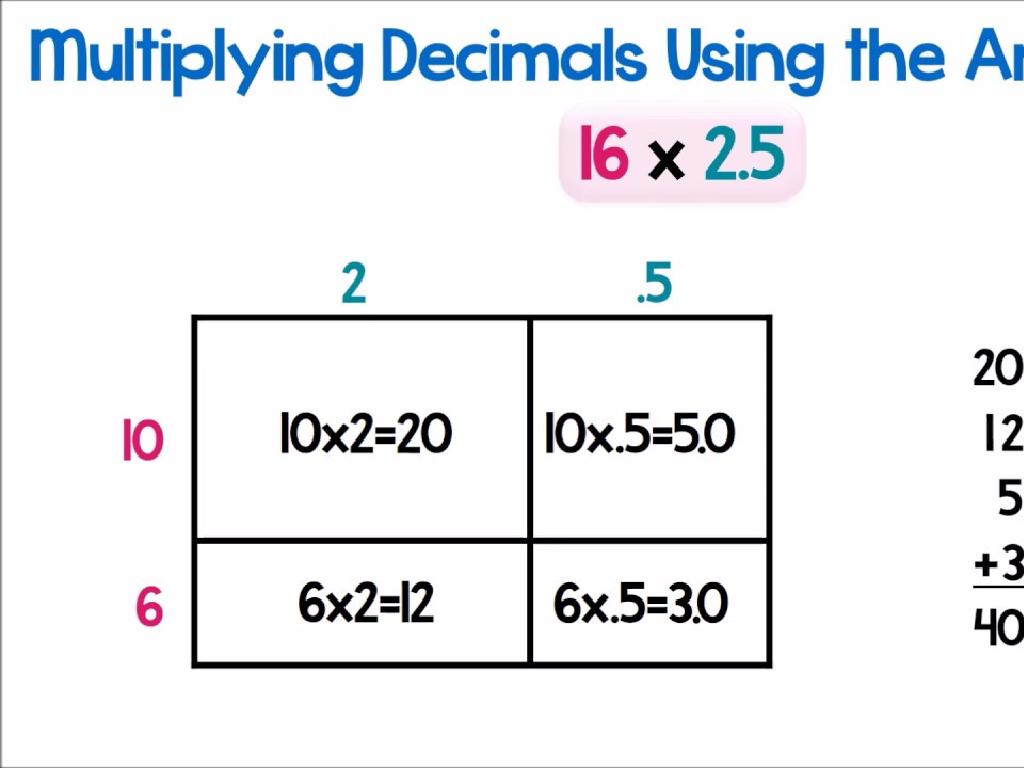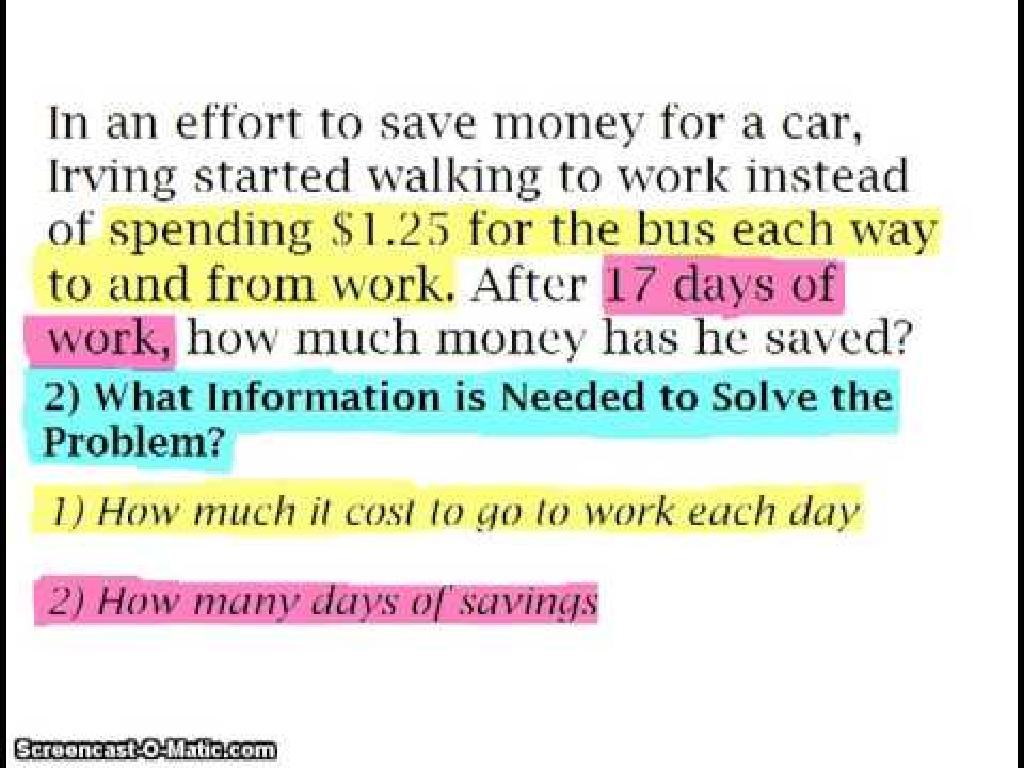Add And Subtract Whole Numbers
Subject: Math
Grade: Sixth grade
Topic: Add And Subtract Whole Numbers
Please LOG IN to download the presentation. Access is available to registered users only.
View More Content
Welcome to Addition and Subtraction!
– Understanding whole numbers
– Today’s goal: Master addition & subtraction
– The importance of these skills
– Essential for daily tasks like shopping or banking
– Practical applications
– Use in budgeting, cooking, or planning events
|
This slide introduces the fundamental concepts of addition and subtraction of whole numbers, setting the stage for today’s lesson. Begin by ensuring that students have a solid grasp of what whole numbers are. Emphasize that the day’s goal is not just to learn but to master the addition and subtraction of these numbers. Discuss why these skills are crucial: they are the building blocks for more advanced math and are used in everyday life. Provide examples such as making purchases, managing finances, cooking, and event planning to illustrate how these skills apply in practical scenarios. Encourage students to think of other areas where they use addition and subtraction. This will help them understand the relevance and motivate them to learn.
Understanding Whole Numbers
– Whole numbers: positive and zero
– No fractions or decimals included
– Examples: 0, 1, 2, 3, 4, …
– Counting objects: 0 apples, 1 apple, 2 apples…
– Used in daily counting and math
– Whole numbers are essential in basic arithmetic operations like addition and subtraction.
|
This slide introduces the concept of whole numbers, which are the foundation of arithmetic. Whole numbers include all positive numbers and zero but exclude fractions and decimals. Use everyday examples like counting objects to illustrate what whole numbers are. Emphasize that these are the numbers students use daily without even thinking about it, such as when they count money, measure ingredients for a recipe, or keep score in a game. Understanding whole numbers is crucial before moving on to more complex mathematical concepts like addition and subtraction of whole numbers.
Addition of Whole Numbers
– Combining whole numbers
– When we add, we put together numbers to make a new total.
– The result is called the sum
– ‘Sum’ is the term for the total we get after addition.
– Example: 7 + 3 = 10
– Adding 7 and 3 gives us 10, which is the sum.
|
This slide introduces the concept of addition as a fundamental mathematical operation. Emphasize that addition is about combining two or more numbers to find their total. The term ‘sum’ should be highlighted as the result of this process. Use the example provided to show a simple addition problem, and encourage students to think of addition as not just a calculation, but as a way to combine quantities in real life, such as adding apples in a basket or combining two groups of people. Have students practice with additional examples and use manipulatives if necessary to visualize the concept.
Subtraction of Whole Numbers
– Subtraction removes one number from another
– If you have 15 apples and give away 6, you have 9 left.
– ‘Difference’ is the result of subtraction
– The difference between 15 and 6 is 9.
– Example: 15 – 6 = 9
– This shows taking 6 away from 15 leaves us with 9.
|
This slide introduces the concept of subtraction as a fundamental arithmetic operation. Subtraction is described as the process of taking away one whole number from another, and the term ‘difference’ is defined as the result of this operation. The example provided, 15 minus 6 equals 9, illustrates a simple subtraction problem. Encourage students to think of subtraction as ‘taking away’ or ‘removing’ objects from a group. Use real-life scenarios, such as the apple example in the sub_content, to help students visualize the concept. Ask students to come up with their own subtraction examples and find the differences to reinforce their understanding.
Carrying Over in Addition
– Understanding carrying over
– When sum exceeds 9, add to next place value
– Example: Adding 58 + 47
– 5+4=9, 8+7=15, write 5, carry 1 to make 10
– Practice problem: 76 + 89
– Solve as a class, step by step
– Why carrying over matters
|
This slide introduces the concept of carrying over in addition, which is crucial when the sum of digits in a column exceeds 9. Start with an example, such as 58 + 47, to show how to carry over the 1 when the units column adds up to 15. Then, move on to a practice problem, 76 + 89, and solve it together with the class, ensuring to demonstrate each step clearly. Emphasize the importance of carrying over as it helps maintain the correct place value and accuracy in addition. Encourage students to ask questions and provide additional examples if needed.
Borrowing in Subtraction
– Borrow from the next place value
– When a smaller digit is subtracted from a larger one in a column, borrow 1 from the next left column
– Example: 73 – 58
– 73 – 58: Borrow from the tens to subtract 8 from 13
– Practice problem: 82 – 57
– Let’s solve 82 – 57 step by step together
|
This slide introduces the concept of borrowing in subtraction, which is necessary when a larger digit is subtracted from a smaller one in a given place value. Start by explaining the need to ‘borrow’ or ‘regroup’ from the next higher place value to make the subtraction possible. Use the example 73 – 58 to illustrate the process, showing how to borrow 1 from the tens place to turn 73 into 63 and 13 in the ones place. Then, guide students through the practice problem 82 – 57, encouraging them to apply the borrowing technique. Ensure to provide step-by-step guidance and allow students to ask questions for clarification. This practice will help solidify their understanding of borrowing in subtraction.
Addition and Subtraction Word Problems
– Applying math to real life
– Reading and identifying numbers
– Find keywords like ‘total’ for addition, ‘left’ for subtraction
– Solving a problem step by step
– We’ll go through a problem as a class
– Practice with a class example
– Example: If you have 10 apples and buy 7 more, how many do you have?
|
This slide introduces students to the practical application of addition and subtraction through word problems. Emphasize the importance of carefully reading the problem to understand what is being asked. Guide students to look for keywords that indicate whether to add or subtract. Work through a sample problem together, demonstrating how to break down the problem into manageable steps. Encourage students to visualize the problem and use their critical thinking skills to solve it. After the example, provide additional problems for students to practice individually or in small groups, ensuring they grasp the concept.
Class Activity: Math Relay!
– Teams solve math problems
– One problem per team member
– Pass the baton after solving
– First team with correct answers wins
|
This activity is designed to encourage teamwork and quick problem-solving skills. Divide the class into small teams, ensuring an equal number of members as much as possible. Each team will receive a set of addition and subtraction problems. One member from each team will solve a problem before passing on the ‘baton’ which could be any classroom object to the next member. The activity continues until one team completes all problems correctly. Prepare different sets of problems for each team to prevent copying and ensure a fair challenge. Possible variations include a mix of single-step and multi-step problems, or incorporating word problems to test comprehension. Monitor the teams to ensure fair play and provide guidance if students are struggling with the concepts.






